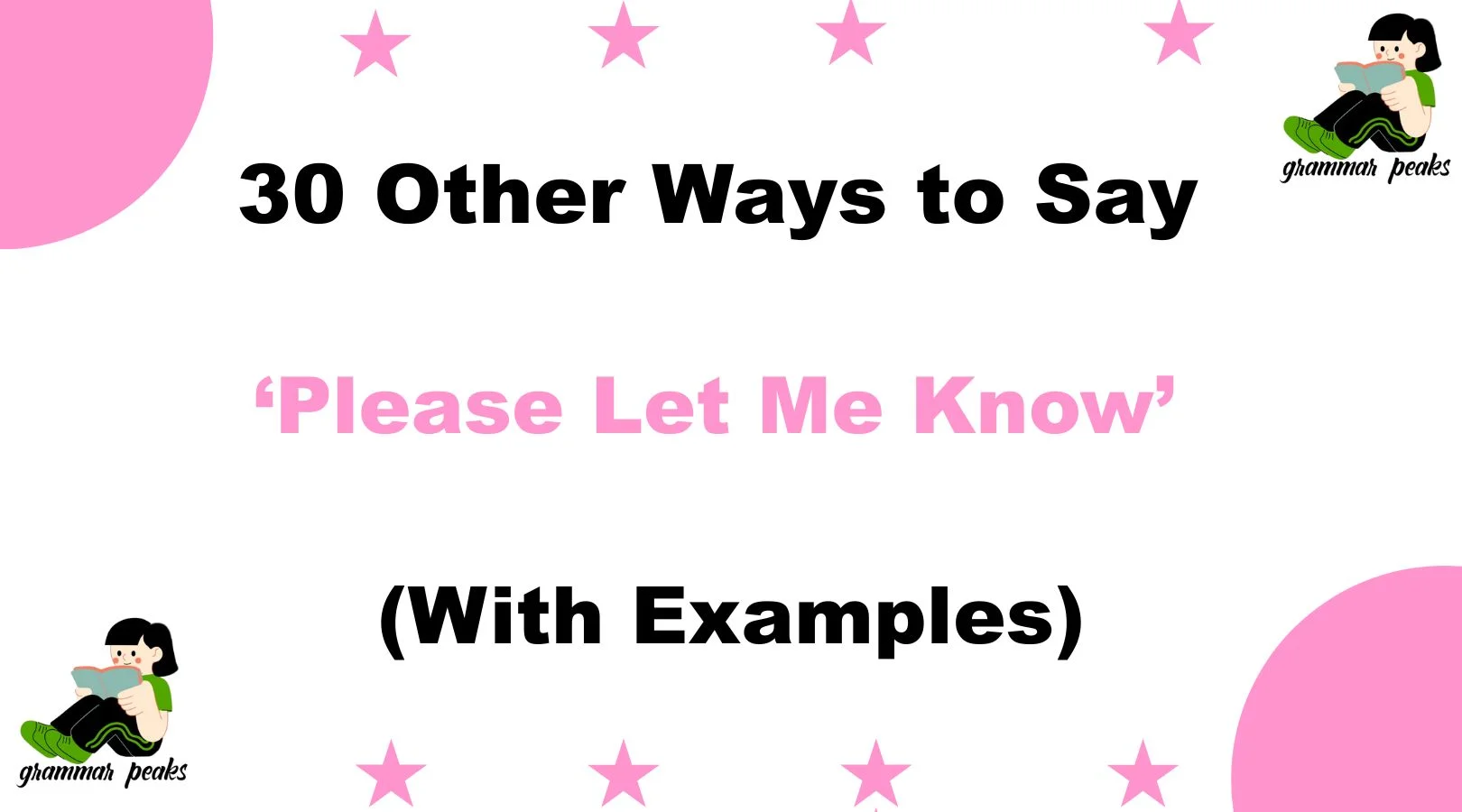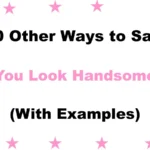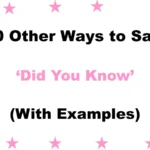Finding the right words to express care and openness can truly deepen communication. Saying “please let me know” is common, but sometimes it can feel a bit routine or formal. Exploring thoughtful alternatives allows you to connect more warmly and personally with others.
Whether you’re writing an email, sending a message, or chatting face-to-face, using varied expressions can help your tone feel more genuine, kind, and engaging. This article offers 30 meaningful ways to say “please let me know”, complete with definitions, examples, and advice on when and how to use each phrase for the best effect.
What Does “Please Let Me Know” Mean?
“Please let me know” is a polite and respectful way to ask someone for information, updates, or feedback. It shows that you value their input and are open to hearing from them. Whether used in emails, texts, or conversations, it encourages two-way communication while maintaining a courteous tone. This phrase helps create clarity and keeps the dialogue cooperative and thoughtful.
When to Use “Please Let Me Know”
This phrase is useful when you want to invite a response without sounding demanding. It fits well in professional emails, friendly messages, or any situation where you’re awaiting information or confirmation. It works best when you want to maintain a respectful and approachable tone.
Is It Professional/Polite to Say “Please Let Me Know”?
Yes, “please let me know” is considered both professional and polite. It’s a gentle way to request information or updates without sounding demanding. This phrase shows respect for the other person’s time and encourages open communication.
It works well in emails, meetings, and everyday conversations across professional and personal settings. Using it helps maintain a friendly and cooperative tone, making interactions smoother and more effective.
Pros and Cons of Using “Please Let Me Know”
Pros:
- Clear and direct
- Polite and respectful
- Easily understood by most readers
Cons:
- Can feel repetitive or formulaic
- Sometimes too formal or distant
- Lacks emotional warmth in casual contexts
Synonyms for “Please Let Me Know”
- Kindly inform me
- I’d appreciate your feedback
- Please keep me posted
- Let me hear from you
- Could you update me?
- Don’t hesitate to reach out
- Keep me in the loop
- I look forward to your response
- Please advise
- Let me know your thoughts
- Feel free to contact me
- I await your reply
- Give me a shout
- Notify me when you can
- Reach out anytime
- I’m eager to hear from you
- Let me know what you decide
- Drop me a line
- Keep me updated
- I’d love your input
- Get back to me when possible
- Please share your decision
- Do keep me informed
- Awaiting your update
- Please respond at your earliest convenience
- Let me know if you have any questions
- Touch base with me
- Let me know if anything changes
- Please confirm when you can
- I welcome your feedback
1. Kindly Inform Me
Definition: A polite way to ask someone to share information.
Explanation: “Kindly inform me” adds a respectful and formal tone to the request.
Scenario Example: Kindly inform me of any changes to the schedule.
Best Use: Formal emails or requests to colleagues or clients.
Worst Use: Casual conversations, as it may sound stiff.
Tone: Formal, respectful, courteous.
2. I’d Appreciate Your Feedback
Definition: Asking someone to share their opinions or thoughts.
Explanation: This phrase shows value for the other person’s insights, making the request more personal.
Scenario Example: I’d appreciate your feedback on the report.
Best Use: When seeking opinions or evaluations.
Worst Use: When just needing factual updates, not opinions.
Tone: Warm, appreciative, open.
3. Please Keep Me Posted
Definition: Asking to be regularly updated on a situation.
Explanation: Casual and friendly, it invites ongoing communication.
Scenario Example: Please keep me posted on the project progress.
Best Use: Informal workplace settings or among friends.
Worst Use: Very formal or serious communications.
Tone: Friendly, informal, approachable.
4. Let Me Hear From You
Definition: Requesting a response or update.
Explanation: Suggests eagerness to receive communication, friendly in tone.
Scenario Example: Let me hear from you once you’ve reviewed the documents.
Best Use: Personal or informal professional contexts.
Worst Use: Very formal or official situations.
Tone: Casual, warm, inviting.
5. Could You Update Me?
Definition: A polite way to request the latest information.
Explanation: Slightly formal and direct, good for business contexts.
Scenario Example: Could you update me on the client’s feedback?
Best Use: Professional emails and meetings.
Worst Use: Overly casual conversations.
Tone: Polite, professional, clear.
6. Don’t Hesitate to Reach Out
Definition: Encourages the other person to contact you without reservation.
Explanation: Shows openness and support, making the conversation welcoming.
Scenario Example: Don’t hesitate to reach out if you need assistance.
Best Use: Customer service, mentorship, or supportive roles.
Worst Use: When you need a direct answer rather than open communication.
Tone: Supportive, warm, inviting.
7. Keep Me in the Loop
Definition: Request to be informed of all developments.
Explanation: Casual and collaborative, often used among team members.
Scenario Example: Keep me in the loop regarding the marketing strategy.
Best Use: Team projects or informal professional settings.
Worst Use: Formal or hierarchical communication.
Tone: Casual, friendly, cooperative.
8. I Look Forward to Your Response
Definition: Politely expressing anticipation for a reply.
Explanation: Formal and courteous, often used to close emails.
Scenario Example: I look forward to your response on the proposal.
Best Use: Business emails and formal communication.
Worst Use: Casual or quick chats.
Tone: Polite, formal, professional.
9. Please Advise
Definition: Asking someone to provide guidance or information.
Explanation: Formal and concise, common in professional writing.
Scenario Example: Please advise on the next steps.
Best Use: Professional emails, especially when requiring direction.
Worst Use: Casual contexts or where warmth is needed.
Tone: Formal, direct, businesslike.
10. Let Me Know Your Thoughts
Definition: Inviting someone to share their opinions.
Explanation: Shows interest in the other person’s perspective, warm and engaging.
Scenario Example: Let me know your thoughts on the design.
Best Use: When feedback or ideas are requested.
Worst Use: When only factual updates are needed.
Tone: Friendly, interested, conversational.
11. Feel Free to Contact Me
Definition: Giving permission to reach out anytime.
Explanation: Encouraging and open, perfect for customer or client communication.
Scenario Example: Feel free to contact me if you have any questions.
Best Use: Customer service, support roles.
Worst Use: Situations requiring scheduled or formal communication.
Tone: Welcoming, supportive, approachable.
12. I Await Your Reply
Definition: Polite phrase expressing that you are waiting for a response.
Explanation: Formal and clear, good for official communications.
Scenario Example: I await your reply regarding the contract.
Best Use: Business emails or formal letters.
Worst Use: Casual messaging.
Tone: Formal, patient, respectful.
13. Give Me a Shout
Definition: Informal way to ask someone to contact you.
Explanation: Friendly, relaxed, and casual.
Scenario Example: Give me a shout when you’re ready.
Best Use: Among friends or close colleagues.
Worst Use: Formal or professional communication.
Tone: Casual, friendly, easygoing.
14. Notify Me When You Can
Definition: Polite request to inform at the person’s earliest convenience.
Explanation: Respectful of the other person’s time and schedule.
Scenario Example: Notify me when you can about the meeting time.
Best Use: Semi-formal communication where patience is expected.
Worst Use: Urgent situations.
Tone: Polite, patient, considerate.
15. Reach Out Anytime
Definition: Invitation for open and ongoing communication.
Explanation: Supportive and encouraging, expressing availability.
Scenario Example: Reach out anytime if you need help.
Best Use: Customer support, mentorship, or friendly relationships.
Worst Use: Formal or very brief communications.
Tone: Warm, open, friendly.
16. I’m Eager to Hear From You
Definition: Expresses anticipation and interest in a reply.
Explanation: Friendly and enthusiastic tone showing genuine care.
Scenario Example: I’m eager to hear from you about your decision.
Best Use: Personal or semi-formal communications.
Worst Use: Very formal contexts.
Tone: Warm, eager, personal.
17. Let Me Know What You Decide
Definition: Requesting information about a decision.
Explanation: Clear and direct, with a focus on outcome.
Scenario Example: Let me know what you decide about the proposal.
Best Use: When awaiting a clear choice or response.
Worst Use: When input or feedback is requested instead.
Tone: Direct, clear, polite.
18. Drop Me a Line
Definition: Casual way to ask for a message or update.
Explanation: Informal and friendly, often used in social contexts.
Scenario Example: Drop me a line when you get a chance.
Best Use: Among friends or informal contacts.
Worst Use: Formal or professional communication.
Tone: Casual, friendly, relaxed.
19. Keep Me Updated
Definition: Asking to receive ongoing information.
Explanation: Straightforward and polite.
Scenario Example: Keep me updated on any new developments.
Best Use: Work-related or project communications.
Worst Use: When a one-time update is sufficient.
Tone: Neutral, professional, polite.
20. I’d Love Your Input
Definition: Inviting someone’s opinions or ideas warmly.
Explanation: Shows genuine interest in collaboration.
Scenario Example: I’d love your input on the marketing plan.
Best Use: Creative or team environments.
Worst Use: When just factual information is required.
Tone: Friendly, open, appreciative.
21. Get Back to Me When Possible
Definition: Polite request for a response when convenient.
Explanation: Respectful of the other person’s time.
Scenario Example: Get back to me when possible with the details.
Best Use: Semi-formal emails.
Worst Use: Urgent matters.
Tone: Polite, patient, considerate.
22. Please Share Your Decision
Definition: Asking clearly for a choice or conclusion.
Explanation: Direct but polite.
Scenario Example: Please share your decision regarding the offer.
Best Use: Professional or formal contexts.
Worst Use: When only updates or feedback are requested.
Tone: Formal, clear, polite.
23. Do Keep Me Informed
Definition: Request for ongoing information.
Explanation: Slightly formal and respectful.
Scenario Example: Do keep me informed about any changes.
Best Use: Professional or official communication.
Worst Use: Casual or very informal chats.
Tone: Formal, polite, clear.
24. Awaiting Your Update
Definition: Politely stating you are waiting for information.
Explanation: Formal and professional.
Scenario Example: Awaiting your update on the project status.
Best Use: Business emails or reports.
Worst Use: Casual conversations.
Tone: Formal, patient, professional.
25. Please Respond at Your Earliest Convenience
Definition: Polite request for a timely reply.
Explanation: Shows urgency without pressure.
Scenario Example: Please respond at your earliest convenience regarding the contract.
Best Use: Formal and semi-formal communication.
Worst Use: Informal chats or non-urgent matters.
Tone: Polite, formal, considerate.
26. Let Me Know If You Have Any Questions
Definition: Inviting questions for clarity or further discussion.
Explanation: Shows openness and willingness to help.
Scenario Example: Let me know if you have any questions about the proposal.
Best Use: Customer support, education, or informative contexts.
Worst Use: When a direct response is expected.
Tone: Friendly, helpful, supportive.
27. Touch Base With Me
Definition: Casual phrase meaning to check in or communicate briefly.
Explanation: Common in business but informal.
Scenario Example: Please touch base with me after the meeting.
Best Use: Team communication or project updates.
Worst Use: Very formal communication.
Tone: Casual, professional, friendly.
28. Let Me Know If Anything Changes
Definition: Request to be informed of updates or alterations.
Explanation: Practical and considerate.
Scenario Example: Let me know if anything changes with the schedule.
Best Use: Ongoing projects or plans.
Worst Use: When only a one-time reply is needed.
Tone: Polite, neutral, clear.
29. Please Confirm When You Can
Definition: Request for acknowledgment or validation.
Explanation: Polite and professional, often for logistics.
Scenario Example: Please confirm when you can attend the meeting.
Best Use: Formal or business situations.
Worst Use: Informal conversations.
Tone: Formal, courteous, clear.
30. I Welcome Your Feedback
Definition: Inviting open opinions or suggestions warmly.
Explanation: Encourages dialogue and shows openness.
Scenario Example: I welcome your feedback on the presentation.
Best Use: Collaborative or creative environments.
Worst Use: When only factual updates are needed.
Tone: Warm, open, appreciative.
Conclusion
Choosing the right way to say “please let me know” can transform your communication from routine to meaningful. Each alternative brings its own nuance—whether it’s the formal respect of “kindly inform me,” the friendly warmth of “give me a shout,” or the supportive openness of “don’t hesitate to reach out.”
Understanding when and how to use these phrases helps you connect more deeply, respect the context, and express genuine care. So next time you want to stay connected, pick the phrase that feels most thoughtful and authentic—your words truly matter.
FAQs
1. What does “Please let me know” really mean in communication?
“Please let me know” is a polite way of asking someone to share information or update you. It shows respect for the other person’s time and input, creating an open and caring dialogue. Using this phrase or its alternatives can help keep conversations clear and meaningful.
2. When is the best time to use “Please let me know” or its alternatives?
This phrase works best when you want to encourage feedback, confirmation, or updates—whether in emails, messages, or conversations. It’s perfect for professional settings, casual chats, or any situation where you want to express genuine interest in a response.
3. Are all alternatives to “Please let me know” equally polite and professional?
Not exactly. Some alternatives are more casual or informal, while others suit formal or business communications better. Choosing the right phrase depends on your audience, relationship, and context—this article helps you pick the perfect tone every time.
4. Can using different ways to say “Please let me know” improve my relationships?
Absolutely! Using varied, warm, and thoughtful expressions shows attentiveness and care. It helps your messages feel more personalized and genuine, which can strengthen both professional and personal connections.
5. How can I make sure my request for information doesn’t sound pushy?
Using polite, open-ended phrases like those shared in this article encourages a positive response without pressure. Adding warmth, appreciation, or understanding tones makes your request inviting rather than demanding.

Mariah Cannon is a dedicated Senior Content Specialist at GrammarPeaks, known for her clear, engaging writing and deep knowledge of English grammar and usage. With a background in linguistics and years of experience in content development, Mariah crafts informative and accessible articles that empower readers to master the nuances of the English language. Her work reflects a commitment to clarity, education, and helping others express themselves with confidence.





